Evaluation of Cloud Mask and Cloud Top Height from Fengyun-4A with MODIS Cloud Retrievals over the Tibetan Plateau
Abstract
1. Introduction
2. Moderate Resolution Imaging (MODIS) and Advanced Geosynchronous Radiation Imager (AGRI) Measurements
2.1. Moderate Resolution Imaging (MODIS)
2.2. Advanced Geosynchronous Radiation Imager (AGRI)
3. Collocation and Evaluation Methodology
3.1. Collocation and Evaluation Methodology
3.2. Evaluation Methodology
4. Results
4.1. Cloud Mask
4.2. Cloud Top Height
5. Discussion
6. Conclusions
Author Contributions
Funding
Data Availability Statement
Acknowledgments
Conflicts of Interest
References
- Wielicki, B.A.; Parker, L. On the determination of cloud cover from satellite sensors—The effect of sensor spatial-resolution. J. Geophys. Res. Atmos. 1992, 97, 12799–12823. [Google Scholar] [CrossRef]
- Stubenrauch, C.J.; Rossow, W.B.; Kinne, S.; Ackerman, S.; Cesana, G.; Chepfer, H.; Di Girolamo, L.; Getzewich, B.; Guignard, A.; Heidinger, A.; et al. Assessment of global cloud datasets from satellites: Project and database initiated by the gewex radiation panel. Bull. Am. Meteorol. Soc. 2013, 94, 1031–1049. [Google Scholar] [CrossRef]
- Stephens, G.L.; Vane, D.G.; Boain, R.J.; Mace, G.G.; Sassen, K.; Wang, Z.E.; Illingworth, A.J.; O’Connor, E.J.; Rossow, W.B.; Durden, S.L.; et al. The cloudsat mission and the a-train—A new dimension of space-based observations of clouds and precipitation. Bull. Am. Meteorol. Soc. 2002, 83, 1771–1790. [Google Scholar] [CrossRef]
- Rossow, W.B.; Schiffer, R.A. Advances in understanding clouds from isccp. Bull. Am. Meteorol. Soc. 1999, 80, 2261–2287. [Google Scholar] [CrossRef]
- Stephens, G.L.; Christensen, M.; Andrews, T.; Haywood, J.; Malavelle, F.F.; Suzuki, K.; Jing, X.W.; Lebsock, M.; Li, J.L.F.; Takahashi, H.; et al. Cloud physics from space. Q. J. R. Meteorol. Soc. 2019, 145, 2854–2875. [Google Scholar] [CrossRef]
- Boucher, O.; Randall, D.; Artaxo, P.; Bretherton, C.; Feingold, G.; Forster, P.; Kerminen, V.-M.; Kondo, Y.; Lia, H.; Lohmann, U.; et al. Clouds and aerosols. In Climate Change 2013: The Physical Science Basis. Contribution of Working Group i to the Fifth Assessment Report of the Intergovernmental Panel on Climate Change; Cambridge University Press: Cambridge, UK, 2013. [Google Scholar]
- Sato, T. Impact of diabatic heating over the tibetan plateau on subsidence over northeast Asian arid region. Geophys. Res. Lett. 2005, 32. [Google Scholar] [CrossRef]
- Kutzbach, J.E.; Guetter, P.J.; Ruddiman, W.F.; Prell, W.L. Sensitivity of climate to late cenozoic uplift in southern asia and the american west—Numerical experiments. J. Geophys. Res. Atmos. 1989, 94, 18393–18407. [Google Scholar] [CrossRef]
- Yanai, M.H.; Li, C.F.; Song, Z.S. Seasonal heating of the tibetan plateau and its effects on the evolution of the asian summer monsoon. J. Meteorol. Soc. Jpn. 1992, 70, 319–351. [Google Scholar] [CrossRef]
- Chen, B.D.; Liu, X.D. Seasonal migration of cirrus clouds over the asian monsoon regions and the tibetan plateau measured from modis/terra. Geophys. Res. Lett. 2005, 32. [Google Scholar] [CrossRef]
- Yu, R.C.; Wang, B.; Zhou, T.J. Climate effects of the deep continental stratus clouds generated by the tibetan plateau. J. Clim. 2004, 17, 2702–2713. [Google Scholar] [CrossRef]
- Tao, S.Y.; Ding, Y.H. Observational evidence of the influence of the qinghai-xizang (tibet) plateau on the occurrence of heavy rain and severe convective storms in China. Bull. Am. Meteorol. Soc. 1981, 62, 23–30. [Google Scholar] [CrossRef]
- Wu, G.; Duan, A.; Liu, Y.; Mao, J.; Ren, R.; Bao, Q.; He, B.; Liu, B.; Hu, W. Tibetan plateau climate dynamics: Recent research progress and outlook. Natl. Sci. Rev. 2015, 2, 100–116. [Google Scholar] [CrossRef]
- Wu, G.; Liu, Y.; Wang, T.; Wan, R.; Liu, X.; Li, W.; Wang, Z.; Zhang, Q.; Duan, A.; Liang, X. The influence of mechanical and thermal forcing by the tibetan plateau on asian climate. J. Hydrometeorol. 2007, 8, 770–789. [Google Scholar] [CrossRef]
- He, B.; Wu, G.; Liu, Y.; Bao, Q. Astronomical and hydrological perspective of mountain impacts on the asian summer monsoon. Sci. Rep. 2015, 5, 1–12. [Google Scholar] [CrossRef]
- Xu, X.; Lu, C.; Shi, X.; Ding, Y. Large-scale topography of China: A factor for the seasonal progression of the meiyu rainband? J. Geophys. Res. Atmos. 2010, 115. [Google Scholar] [CrossRef]
- Xu, X.; Lu, C.; Shi, X.; Gao, S. World water tower: An atmospheric perspective. Geophys. Res. Lett. 2008, 35. [Google Scholar] [CrossRef]
- Fu, Y.; Ma, Y.; Zhong, L.; Yang, Y.; Guo, X.; Wang, C.; Xu, X.; Yang, K.; Xu, X.; Liu, L.; et al. Land-surface processes and summer-cloud-precipitation characteristics in the tibetan plateau and their effects on downstream weather: A review and perspective. Natl. Sci. Rev. 2020, 7, 500–515. [Google Scholar] [CrossRef]
- Stephens, G.; Winker, D.; Pelon, J.; Trepte, C.; Vane, D.; Yuhas, C.; L’Ecuyer, T.; Lebsock, M. Cloudsat and calipso within the a-train: Ten years of actively observing the earth system. Bull. Am. Meteorol. Soc. 2018, 99, 569–581. [Google Scholar] [CrossRef]
- Gao, B.C.; Yang, P.; Guo, G.; Park, S.K.; Wiscombe, W.J.; Chen, B. Measurements of water vapor and high clouds over the tibetan plateau with the terra modis instrument. IEEE Trans. Geosci. Remote Sens. 2003, 41, 895–900. [Google Scholar]
- Yafei, Y.; Xiaocong, W.; Yimin, L. Cloud vertical structures associated with precipitation magnitudes over the tibetan plateau and its neighboring regions. Atmos. Ocean. Sci. Lett. 2018, 11, 44–53. [Google Scholar]
- Yan, Y.F.; Liu, Y.M.; Lu, J.H. Cloud vertical structure, precipitation, and cloud radiative effects over tibetan plateau and its neighboring regions. J. Geophys. Res. Atmos. 2016, 121, 5864–5877. [Google Scholar] [CrossRef]
- Rossow, W.B.; Cairns, B. Monitoring changes of clouds. Clim. Chang. 1995, 31, 305–347. [Google Scholar] [CrossRef]
- Wang, Y.; Zhao, C. Can modis cloud fraction fully represent the diurnal and seasonal variations at doe arm sgp and manus sites? J. Geophys. Res. Atmos. 2017, 122, 329–343. [Google Scholar] [CrossRef]
- Lei, Y.; Letu, H.; Shang, H.; Shi, J. Cloud cover over the tibetan plateau and eastern China: A comparison of era5 and era-interim with satellite observations. Clim. Dyn. 2020, 54, 2941–2957. [Google Scholar] [CrossRef]
- Yin, J.; Porporato, A. Diurnal cloud cycle biases in climate models. Nat. Commun. 2017, 8, 2269. [Google Scholar] [CrossRef] [PubMed]
- Yin, J.; Porporato, A. Radiative effects of daily cycle of cloud frequency in past and future climates. Clim. Dyn. 2020, 54, 1625–1637. [Google Scholar] [CrossRef]
- Schmit, T.J.; Griffith, P.; Gunshor, M.M.; Daniels, J.M.; Goodman, S.J.; Lebair, W.J. A closer look at the abi on the goes-r series. Bull. Am. Meteorol. Soc. 2017, 98, 681–698. [Google Scholar] [CrossRef]
- Bessho, K.; Date, K.; Hayashi, M.; Ikeda, A.; Imai, T.; Inoue, H.; Kumagai, Y.; Miyakawa, T.; Murata, H.; Ohno, T.; et al. An introduction to himawari-8/9-japan’s new-generation geostationary meteorological satellites. J. Meteorol. Soc. Jpn. 2016, 94, 151–183. [Google Scholar] [CrossRef]
- Min, M.; Wu, C.; Li, C.; Liu, H.; Xu, N.; Wu, X.; Chen, L.; Wang, F.; Sun, F.; Qin, D.; et al. Developing the science product algorithm testbed for Chinese next-generation geostationary meteorological satellites: Fengyun-4 series. J. Meteorol. Res. 2017, 31, 708–719. [Google Scholar] [CrossRef]
- Wang, X.; Min, M.; Wang, F.; Guo, J.; Li, B.; Tang, S. Intercomparisons of cloud mask products among fengyun-4a, himawari-8, and modis. IEEE Trans. Geosci. Remote Sens. 2019, 57, 8827–8839. [Google Scholar] [CrossRef]
- Yang, J.; Zhang, Z.; Wei, C.; Lu, F.; Guo, Q. Introducing the new generation of Chinese geostationary weather satellites, fengyun-4. Bull. Am. Meteorol. Soc. 2017, 98, 1637–1658. [Google Scholar] [CrossRef]
- Chen, D.D.; Guo, J.P.; Wang, H.Q.; Li, J.; Min, M.; Zhao, W.H.; Yao, D. The cloud top distribution and diurnal variation of clouds over east Asia: Preliminary results from advanced himawari imager. J. Geophys. Res. Atmos. 2018, 123, 3724–3739. [Google Scholar] [CrossRef]
- Chen, Y.; Li, W.; Chen, S.; Zhang, A.; Fu, Y. Linkage between the vertical evolution of clouds and droplet growth modes as seen from fy-4a agri and gpm dpr. Geophys. Res. Lett. 2020, 47, e2020GL088312. [Google Scholar] [CrossRef]
- Holz, R.E.; Ackerman, S.A.; Nagle, F.W.; Frey, R.; Dutcher, S.; Kuehn, R.E.; Vaughan, M.A.; Baum, B. Global moderate resolution imaging spectroradiometer (modis) cloud detection and height evaluation using caliop. J. Geophys. Res. Atmos. 2008, 113. [Google Scholar] [CrossRef]
- Lai, R.; Teng, S.; Yi, B.; Letu, H.; Min, M.; Tang, S.; Liu, C. Comparison of cloud properties from himawari-8 and fengyun-4a geostationary satellite radiometers with modis cloud retrievals. Remote Sens. 2019, 11, 1703. [Google Scholar] [CrossRef]
- Min, M.; Li, J.; Wang, F.; Liu, Z.; Menzel, W.P. Retrieval of cloud top properties from advanced geostationary satellite imager measurements based on machine learning algorithms. Remote Sens. Environ. 2020, 239, 111616. [Google Scholar] [CrossRef]
- Wang, T.; Luo, J.L.; Liang, J.L.; Wang, B.J.; Tian, W.S.; Chen, X.Y. Comparisons of agri/fy-4a cloud fraction and cloud top pressure with modis/terra measurements over east Asia. J. Meteorol. Res. 2019, 33, 705–719. [Google Scholar] [CrossRef]
- Sato, T.; Miura, H.; Satoh, M. Spring diurnal cycle of clouds over tibetan plateau: Global cloud-resolving simulations and satellite observations. Geophys. Res. Lett. 2007, 34. [Google Scholar] [CrossRef]
- Kotarba, A.Z. Impact of moderate resolution imaging spectroradiometer (modis) cloud mask interpretation on cloud amount estimation. J. Geophys. Res. Atmos. 2015, 120, 8971–8986. [Google Scholar] [CrossRef]
- Ackerman, S.A.; Holz, R.E.; Frey, R.; Eloranta, E.W.; Maddux, B.C.; McGill, M. Cloud detection with modis. Part ii: Validation. J. Atmos. Ocean. Technol. 2008, 25, 1073–1086. [Google Scholar] [CrossRef]
- Ackerman, S.; Frey, R.; Strabala, K.; Liu, Y.; Gumley, L.; Baum, B.; Menzel, P. Discriminating Clear-Sky from Cloud with Modis Algorithm Theoretical Basis Document (mod35) v6.1; Cooperative Institute for Meteorological Satellite Studies, University of Wisconsin: Madison, WI, USA, 2010. [Google Scholar]
- Qin, Y.; Steven, A.D.L.; Schroeder, T.; McVicar, T.R.; Huang, J.; Cope, M.; Zhou, S. Cloud cover in the australian region: Development and validation of a cloud masking, classification and optical depth retrieval algorithm for the advanced himawari imager. Front. Environ. Sci. 2019, 7, 20. [Google Scholar] [CrossRef]
- Heidinger, A. GOES-R Algorithm Theoretical Basis Document (ATBD)-ABI Cloud Height; NOAA/NESDIS Center for Satellite Applications and Research: 2012, version 3.0. pp. 1–77. Available online: https://www.goes-r.gov/resources/docs.html (accessed on 29 January 2020).
- Cesana, G.; Del Genio, A.D.; Chepfer, H. The cumulus and stratocumulus cloudsat-calipso dataset (casccad). Earth Syst. Sci. Data 2019, 11, 1745–1764. [Google Scholar] [CrossRef]
- Platnick, S.; Meyer, K.G.; King, M.D.; Wind, G.; Amarasinghe, N.; Marchant, B.; Arnold, G.T.; Zhang, Z.; Hubanks, P.A.; Holz, R.E.; et al. The modis cloud optical and microphysical products: Collection 6 updates and examples from terra and aqua. IEEE Trans. Geosci. Remote Sens. 2017, 55, 502–525. [Google Scholar] [CrossRef] [PubMed]
- Heidinger, A.K.; Pavolonis, M.J.; Holz, R.E.; Baum, B.A.; Berthier, S. Using calipso to explore the sensitivity to cirrus height in the infrared observations from npoess/viirs and goes-r/abi. J. Geophys. Res. Atmos. 2010, 115. [Google Scholar] [CrossRef]
- Okamoto, K.; McNally, A.P.; Bell, W. Progress towards the assimilation of all-sky infrared radiances: An evaluation of cloud effects. Q. J. R. Meteorol. Soc. 2014, 140, 1603–1614. [Google Scholar] [CrossRef]
- Frey, R.A.; Ackerman, S.A.; Liu, Y.; Strabala, K.I.; Zhang, H.; Key, J.R.; Wang, X. Cloud detection with modis. Part i: Improvements in the modis cloud mask for collection 5. J. Atmos. Ocean. Technol. 2008, 25, 1057–1072. [Google Scholar] [CrossRef]
- King, M.D.; Menzel, W.P.; Kaufman, Y.J.; Tanre, D.; Gao, B.C.; Platnick, S.; Ackerman, S.A.; Remer, L.A.; Pincus, R.; Hubanks, P.A. Cloud and aerosol properties, precipitable water, and profiles of temperature and water vapor from modis. IEEE Trans. Geosci. Remote Sens. 2003, 41, 442–458. [Google Scholar] [CrossRef]
- Yang, P.; Zhang, L.; Hong, G.; Nasiri, S.L.; Baum, B.A.; Huang, H.-L.; King, M.D.; Platnick, S. Differences between collection 4 and 5 modis ice cloud optical/microphysical products and their impact on radiative forcing simulations. IEEE Trans. Geosci. Remote Sens. 2007, 45, 2886–2899. [Google Scholar] [CrossRef]
- Ackerman, S.A.; Strabala, K.I.; Menzel, W.P.; Frey, R.A.; Moeller, C.C.; Gumley, L.E. Discriminating clear sky from clouds with modis. J. Geophys. Res. Atmos. 1998, 103, 32141–32157. [Google Scholar] [CrossRef]
- Menzel, W.P.; Frey, R.A.; Zhang, H.; Wylie, D.P.; Moeller, C.C.; Holz, R.E.; Maddux, B.; Baum, B.A.; Strabala, K.I.; Gumley, L.E. Modis global cloud-top pressure and amount estimation: Algorithm description and results. J. Appl. Meteorol. Climatol. 2008, 47, 1175–1198. [Google Scholar] [CrossRef]
- Baum, B.A.; Menzel, W.P.; Frey, R.A.; Tobin, D.C.; Holz, R.E.; Ackerman, S.A.; Heidinger, A.K.; Yang, P. Modis cloud-top property refinements for collection 6. J. Appl. Meteorol. Climatol. 2012, 51, 1145–1163. [Google Scholar] [CrossRef]
- Ham, S.-H.; Sohn, B.-J.; Yang, P.; Baum, B.A. Assessment of the quality of modis cloud products from radiance simulations. J. Appl. Meteorol. Climatol. 2009, 48, 1591–1612. [Google Scholar] [CrossRef]
- King, M.D.; Platnick, S.; Menzel, W.P.; Ackerman, S.A.; Hubanks, P.A. Spatial and temporal distribution of clouds observed by modis onboard the terra and aqua satellites. IEEE Trans. Geosci. Remote Sens. 2013, 51, 3826–3852. [Google Scholar] [CrossRef]
- Oreopoulos, L.; Cho, N.; Lee, D.; Kato, S.; Huffman, G.J. An examination of the nature of global modis cloud regimes. J. Geophys. Res. Atmos. 2014, 119, 8362–8383. [Google Scholar] [CrossRef]
- Hong, G.; Yang, P.; Gao, B.-C.; Baum, B.A.; Hu, Y.X.; King, M.D.; Platnick, S. High cloud properties from three years of modis terra and aqua collection-4 data over the tropics. J. Appl. Meteorol. Climatol. 2007, 46, 1840–1856. [Google Scholar] [CrossRef]
- Meyer, K.; Yang, P.; Gao, B.-C. Tropical ice cloud optical depth, ice water path, and frequency fields inferred from the modis level-3 data. Atmos. Res. 2007, 85, 171–182. [Google Scholar] [CrossRef]
- Yuan, T.; Li, Z. General macro- and microphysical properties of deep convective clouds as observed by modis. J. Clim. 2010, 23, 3457–3473. [Google Scholar] [CrossRef]
- Zou, X.L.; Da, C. An objective regional cloud mask algorithm for goes infrared imager radiance assimilation. J. Geophys. Res. Atmos. 2014, 119, 6666–6680. [Google Scholar] [CrossRef]
- Zhuge, X.; Zou, X. Test of a modified infrared-only abi cloud mask algorithm for ahi radiance observations. J. Appl. Meteorol. Climatol. 2016, 55, 2529–2546. [Google Scholar] [CrossRef]
- Smith, W.L.; Platt, C.M.R. Comparison of satellite-deduced cloud heights with indications from radiosonde and ground-based laser measurements. J. Appl. Meteorol. 1978, 17, 1796–1802. [Google Scholar] [CrossRef]
- Heidinger, A.K.; Pavolonis, M.J. Gazing at cirrus clouds for 25 years through a split window. Part i: Methodology. J. Appl. Meteorol. Climatol. 2009, 48, 1100–1116. [Google Scholar] [CrossRef]
- Yan, Y.; Liu, Y. Vertical structures of convective and stratiform clouds in boreal summer over the tibetan plateau and its neighboring regions. Adv. Atmos. Sci. 2019, 36, 1089–1102. [Google Scholar] [CrossRef]
- Yu, L.; Fu, Y.; Yang, Y.; Pan, X.; Tan, R. Trumpet-shaped topography modulation of the frequency, vertical structures, and water path of cloud systems in the summertime over the southeastern tibetan plateau: A perspective of daytime-nighttime differences. J. Geophys. Res. Atmos. 2020, 125, e2019JD031803. [Google Scholar] [CrossRef]
- Luo, Y.; Zhang, R.; Qian, W.; Luo, Z.; Hu, X. Intercomparison of deep convection over the tibetan plateau-asian monsoon region and subtropical north america in boreal summer using cloudsat/calipso data. J. Clim. 2011, 24, 2164–2177. [Google Scholar] [CrossRef]
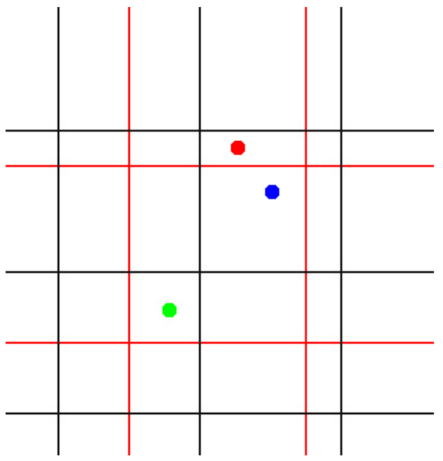
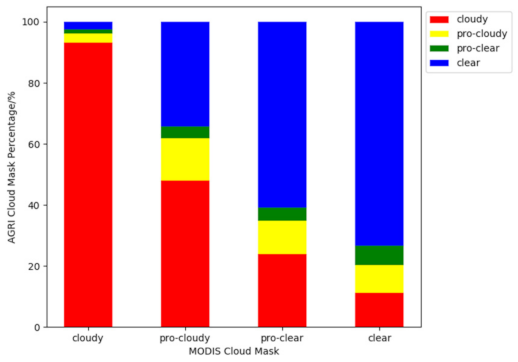
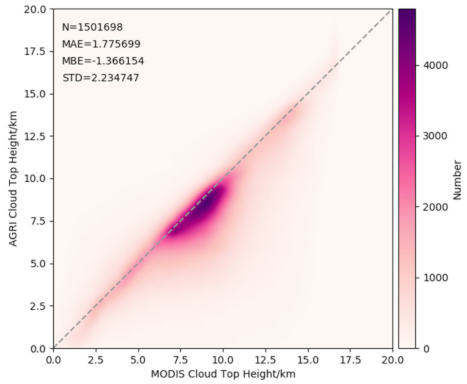
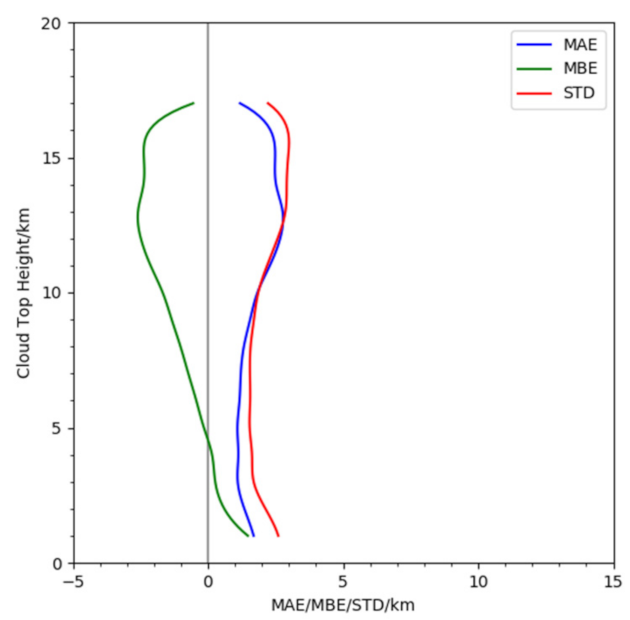
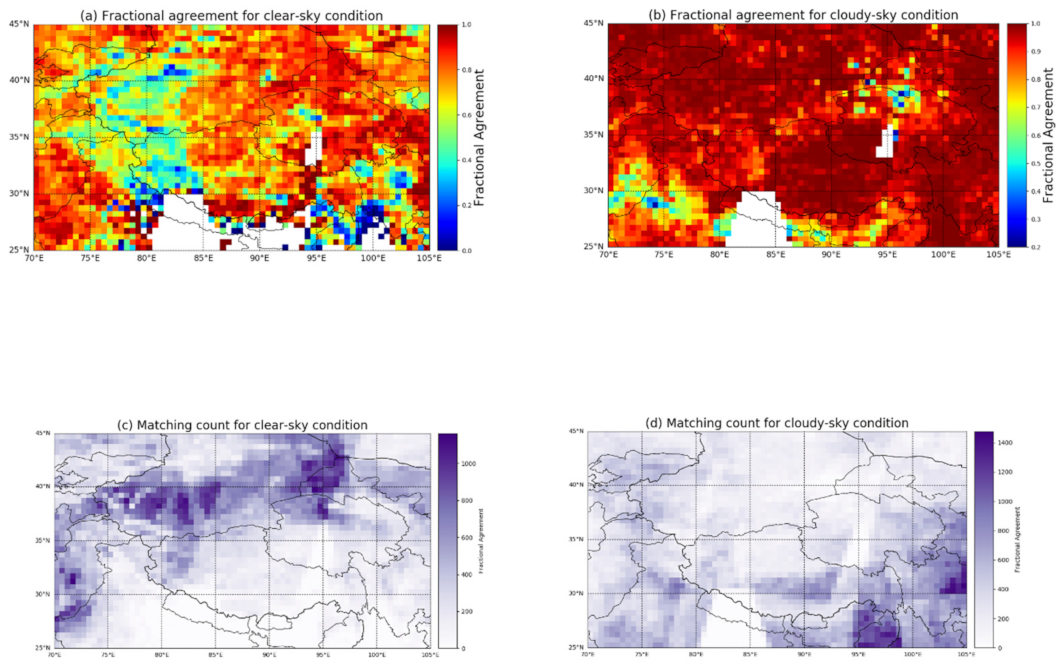


| Cloud Mask Channels (µm) | Cloud Top Height Channels (µm) | |
|---|---|---|
| MODIS | 0.659, 0.865, 0.47, 0.555, 1.24, 1.64, 2.13, 0.415, 0.443, 0.905, 0.936, 3.75, 3.959, 1.375, 6.175, 7.235, 8.55, 11.03, 12.02, 13.335, 13.935 | 11.03, 13.335, 13.635, 13.935, 14.235 |
| AGRI | 0.65, 1.60, 3.8, 7.12, 11.0, 12.09 | 11.0, 12.09, 13.55 |
| Month | Collocated Samples | Cloudy | Clear | HR | ||||
|---|---|---|---|---|---|---|---|---|
| Agreement | POD | FAR | Agreement | POD | FAR | |||
| Jun. | 615,076 | 0.941 | 0.971 | 0.078 | 0.726 | 0.868 | 0.051 | 0.932 |
| Jul. | 667,130 | 0. 942 | 0.975 | 0.064 | 0.764 | 0.909 | 0.035 | 0.947 |
| Aug. | 714,889 | 0.915 | 0.972 | 0.137 | 0.713 | 0.832 | 0.035 | 0.905 |
| ALL | 1,997,095 | 0.932 | 0.973 | 0.093 | 0.734 | 0.868 | 0.040 | 0.927 |
| Month | Collocated Samples | MAE (km) | MBE (km) | STD (km) | CC |
|---|---|---|---|---|---|
| Jun. | 510,529 | 1.501 | −1.037 | 2.006 | 0.773 |
| Jul. | 492,715 | 1.902 | −1.541 | 2.266 | 0.760 |
| Aug. | 498,454 | 1.933 | −1.531 | 2.383 | 0.748 |
| ALL | 1,501,698 | 1.776 | −1.366 | 2.235 | 0.759 |
Publisher’s Note: MDPI stays neutral with regard to jurisdictional claims in published maps and institutional affiliations. |
© 2021 by the authors. Licensee MDPI, Basel, Switzerland. This article is an open access article distributed under the terms and conditions of the Creative Commons Attribution (CC BY) license (https://creativecommons.org/licenses/by/4.0/).
Share and Cite
Xu, W.; Lyu, D. Evaluation of Cloud Mask and Cloud Top Height from Fengyun-4A with MODIS Cloud Retrievals over the Tibetan Plateau. Remote Sens. 2021, 13, 1418. https://doi.org/10.3390/rs13081418
Xu W, Lyu D. Evaluation of Cloud Mask and Cloud Top Height from Fengyun-4A with MODIS Cloud Retrievals over the Tibetan Plateau. Remote Sensing. 2021; 13(8):1418. https://doi.org/10.3390/rs13081418
Chicago/Turabian StyleXu, Wenjing, and Daren Lyu. 2021. "Evaluation of Cloud Mask and Cloud Top Height from Fengyun-4A with MODIS Cloud Retrievals over the Tibetan Plateau" Remote Sensing 13, no. 8: 1418. https://doi.org/10.3390/rs13081418
APA StyleXu, W., & Lyu, D. (2021). Evaluation of Cloud Mask and Cloud Top Height from Fengyun-4A with MODIS Cloud Retrievals over the Tibetan Plateau. Remote Sensing, 13(8), 1418. https://doi.org/10.3390/rs13081418







